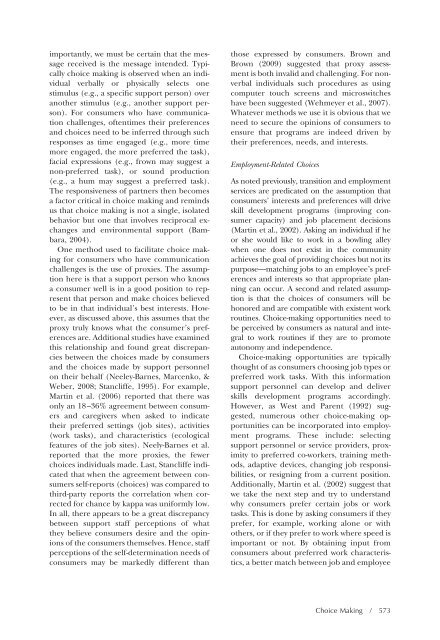etadd_46(4) - Division on Autism and Developmental Disabilities
etadd_46(4) - Division on Autism and Developmental Disabilities
etadd_46(4) - Division on Autism and Developmental Disabilities
Create successful ePaper yourself
Turn your PDF publications into a flip-book with our unique Google optimized e-Paper software.
importantly, we must be certain that the message<br />
received is the message intended. Typically<br />
choice making is observed when an individual<br />
verbally or physically selects <strong>on</strong>e<br />
stimulus (e.g., a specific support pers<strong>on</strong>) over<br />
another stimulus (e.g., another support pers<strong>on</strong>).<br />
For c<strong>on</strong>sumers who have communicati<strong>on</strong><br />
challenges, oftentimes their preferences<br />
<strong>and</strong> choices need to be inferred through such<br />
resp<strong>on</strong>ses as time engaged (e.g., more time<br />
more engaged, the more preferred the task),<br />
facial expressi<strong>on</strong>s (e.g., frown may suggest a<br />
n<strong>on</strong>-preferred task), or sound producti<strong>on</strong><br />
(e.g., a hum may suggest a preferred task).<br />
The resp<strong>on</strong>siveness of partners then becomes<br />
a factor critical in choice making <strong>and</strong> reminds<br />
us that choice making is not a single, isolated<br />
behavior but <strong>on</strong>e that involves reciprocal exchanges<br />
<strong>and</strong> envir<strong>on</strong>mental support (Bambara,<br />
2004).<br />
One method used to facilitate choice making<br />
for c<strong>on</strong>sumers who have communicati<strong>on</strong><br />
challenges is the use of proxies. The assumpti<strong>on</strong><br />
here is that a support pers<strong>on</strong> who knows<br />
a c<strong>on</strong>sumer well is in a good positi<strong>on</strong> to represent<br />
that pers<strong>on</strong> <strong>and</strong> make choices believed<br />
to be in that individual’s best interests. However,<br />
as discussed above, this assumes that the<br />
proxy truly knows what the c<strong>on</strong>sumer’s preferences<br />
are. Additi<strong>on</strong>al studies have examined<br />
this relati<strong>on</strong>ship <strong>and</strong> found great discrepancies<br />
between the choices made by c<strong>on</strong>sumers<br />
<strong>and</strong> the choices made by support pers<strong>on</strong>nel<br />
<strong>on</strong> their behalf (Neeley-Barnes, Marcenko, &<br />
Weber, 2008; Stancliffe, 1995). For example,<br />
Martin et al. (2006) reported that there was<br />
<strong>on</strong>ly an 18–36% agreement between c<strong>on</strong>sumers<br />
<strong>and</strong> caregivers when asked to indicate<br />
their preferred settings (job sites), activities<br />
(work tasks), <strong>and</strong> characteristics (ecological<br />
features of the job sites). Neely-Barnes et al.<br />
reported that the more proxies, the fewer<br />
choices individuals made. Last, Stancliffe indicated<br />
that when the agreement between c<strong>on</strong>sumers<br />
self-reports (choices) was compared to<br />
third-party reports the correlati<strong>on</strong> when corrected<br />
for chance by kappa was uniformly low.<br />
In all, there appears to be a great discrepancy<br />
between support staff percepti<strong>on</strong>s of what<br />
they believe c<strong>on</strong>sumers desire <strong>and</strong> the opini<strong>on</strong>s<br />
of the c<strong>on</strong>sumers themselves. Hence, staff<br />
percepti<strong>on</strong>s of the self-determinati<strong>on</strong> needs of<br />
c<strong>on</strong>sumers may be markedly different than<br />
those expressed by c<strong>on</strong>sumers. Brown <strong>and</strong><br />
Brown (2009) suggested that proxy assessment<br />
is both invalid <strong>and</strong> challenging. For n<strong>on</strong>verbal<br />
individuals such procedures as using<br />
computer touch screens <strong>and</strong> microswitches<br />
have been suggested (Wehmeyer et al., 2007).<br />
Whatever methods we use it is obvious that we<br />
need to secure the opini<strong>on</strong>s of c<strong>on</strong>sumers to<br />
ensure that programs are indeed driven by<br />
their preferences, needs, <strong>and</strong> interests.<br />
Employment-Related Choices<br />
As noted previously, transiti<strong>on</strong> <strong>and</strong> employment<br />
services are predicated <strong>on</strong> the assumpti<strong>on</strong> that<br />
c<strong>on</strong>sumers’ interests <strong>and</strong> preferences will drive<br />
skill development programs (improving c<strong>on</strong>sumer<br />
capacity) <strong>and</strong> job placement decisi<strong>on</strong>s<br />
(Martin et al., 2002). Asking an individual if he<br />
or she would like to work in a bowling alley<br />
when <strong>on</strong>e does not exist in the community<br />
achieves the goal of providing choices but not its<br />
purpose—matching jobs to an employee’s preferences<br />
<strong>and</strong> interests so that appropriate planning<br />
can occur. A sec<strong>on</strong>d <strong>and</strong> related assumpti<strong>on</strong><br />
is that the choices of c<strong>on</strong>sumers will be<br />
h<strong>on</strong>ored <strong>and</strong> are compatible with existent work<br />
routines. Choice-making opportunities need to<br />
be perceived by c<strong>on</strong>sumers as natural <strong>and</strong> integral<br />
to work routines if they are to promote<br />
aut<strong>on</strong>omy <strong>and</strong> independence.<br />
Choice-making opportunities are typically<br />
thought of as c<strong>on</strong>sumers choosing job types or<br />
preferred work tasks. With this informati<strong>on</strong><br />
support pers<strong>on</strong>nel can develop <strong>and</strong> deliver<br />
skills development programs accordingly.<br />
However, as West <strong>and</strong> Parent (1992) suggested,<br />
numerous other choice-making opportunities<br />
can be incorporated into employment<br />
programs. These include: selecting<br />
support pers<strong>on</strong>nel or service providers, proximity<br />
to preferred co-workers, training methods,<br />
adaptive devices, changing job resp<strong>on</strong>sibilities,<br />
or resigning from a current positi<strong>on</strong>.<br />
Additi<strong>on</strong>ally, Martin et al. (2002) suggest that<br />
we take the next step <strong>and</strong> try to underst<strong>and</strong><br />
why c<strong>on</strong>sumers prefer certain jobs or work<br />
tasks. This is d<strong>on</strong>e by asking c<strong>on</strong>sumers if they<br />
prefer, for example, working al<strong>on</strong>e or with<br />
others, or if they prefer to work where speed is<br />
important or not. By obtaining input from<br />
c<strong>on</strong>sumers about preferred work characteristics,<br />
a better match between job <strong>and</strong> employee<br />
Choice Making / 573
















